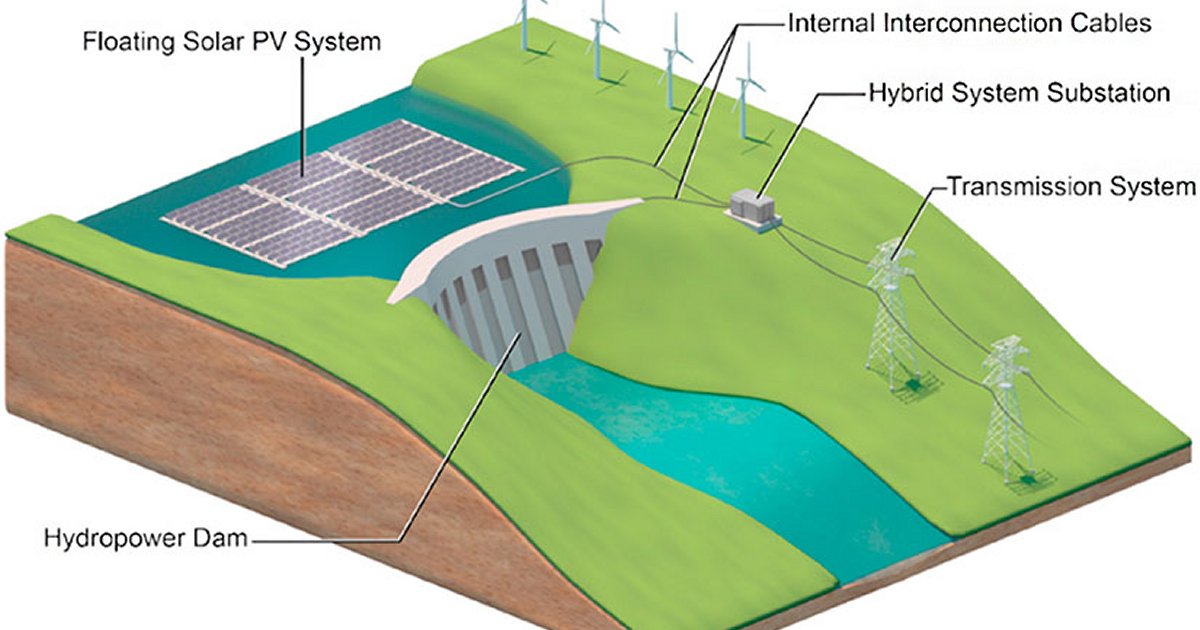
Image: NREL
Adding floating solar panels to hydropower plant reservoirs has the technical potential to supply a significant chunk of the world’s electricity needs.
Analysis carried out by researchers at the U.S. Department of Energy’s National Renewable Energy Laboratory (NREL) identified floating solar power potential as ranging from 3.0 TW to 7.6 TW capacity globally, which could generate 4,251 TWh to 10,616 TWh of electricity annually. Based on the capacity range, the annual output looks a little conservative to me – but they are the guys and gals with the degrees.
Just as an indicator of the impact this could have; total electricity final consumption globally reached 22,315 TWh in 2018 according to the International Energy Agency.
However, lead author of the NREL paper (paywall unfortunately) Nathan Lee stresses the estimate for floating PV at the upper end is “really optimistic”.
“This does not represent what could be economically feasible or what the markets could actually support,” he said. ” Rather, it is an upper-bound estimate of feasible resources that considers waterbody constraints and generation system performance.”
The researchers estimate more than 379,000 (!) freshwater hydropower reservoirs across the world could host combined floating solar with existing hydropower facilities, but additional siting data is required for confirmation.
Some of the other benefits of adding solar to hydropower facilities include reducing transmission costs by linking to a common substation, and solar providing a boost during dry seasons when water levels and consequently hydropower generation may be lower. Surplus solar energy from these installations could also be used for pumped storage applications.
An earlier study by NREL researchers found 24,419 man-made water bodies in the USA (not just hydropower reservoirs) would be suitable for floating solar PV. If a quarter of the surface area of these candidates were covered in solar panels, this could generate the equivalent of almost 10% of U.S. electricity generation.
The Rise Of Floating Solar
Floating solar farms – most not associated with hydropower – have become increasingly common around the world in the past few years. Floating PV is particularly attractive in countries where available land for solar farms is limited. For example, earlier this week Swedish multinational power company Vattenfall officially opened its first floating solar farm (1.2MW capacity) in Gendringen, the Netherlands.
As well as the number of installations, the capacity of floating PV projects has also greatly increased. It was only three years ago when the largest operational facility anywhere in the world was a 40MW project in Huainan, China. In March this year, we reported on a 100MW floating solar project, also in China.
Some solar manufacturers have been getting into “floatovoltaics” in a big way. Among them is inverter manufacturer Sungrow, which has a dedicated research and manufacturing division that was supporting 700MW of floating solar capacity as at the end of 2019.
Closer to home, floating PV has been appearing in Australia, but usually quite small projects. These include an installation at a wastewater treatment facility at Jamestown in South Australia, a 100kW system at Happy Valley Reservoir in Adelaide and a 99kW installation in Lismore, New South Wales.

 RSS - Posts
RSS - Posts



Actually it looks like the floating solar install at Happy Valley Reservoir has been canned in favour of a system on the ground next to it.
“Last year we investigated trialling floating solar panels on Happy Valley Reservoir. Although logistically feasible, with the reservoir providing a large flat surface with good sun exposure, further assessment showed it was not cost-effective and we did not proceed with further investigations. Alyssa@sawater ” about 1 year ago https://watertalks.sawater.com.au/zcef-happy-valley/forum_topics/discussion-forum
Not only is this a great idea, some side effects would be the effect of shading applied to a large body of fresh water and its effects to evaporation during summer and warmer weather.
Imagine the added benefit if the platforms on which the FPV also worked with nature to clean nutrient burdened or chemical-laden water underneath it! The US company BioHaven Floating Island suggests that with their special plants and aeration technology, we’d get energy AND clean water. This could be a solution for two of the big problems we’re facing. You might check that out, Michael. https://www.floatingislandinternational.com